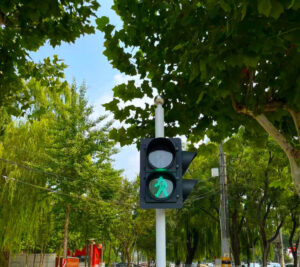High-speed cycling exposes riders to a unique set of hazards: glare from wet roads, sudden changes in lighting, flying debris, and high winds. While helmets and reflective gear are essential, many cyclists overlook the importance of specialized sunglasses.The right pair of cycling sunglasses genuinely enhance road safety.This article explores their role, the underlying technology, and how professional guidance ensures optimal protection.

Table of Contents
Toggle1. Vision Challenges for Cyclists
- Glare, Contrast, and Obstacle Detection
On bright, sunlit roads, glare can reduce visual clarity by up to 60%, delaying reaction times. Cycling sunglasses with polarized or amber lenses improve contrast and visibility, allowing riders to identify obstacles such as potholes, debris, or road markings at distances up to 20 meters farther than with standard sports sunglasses. This advantage is critical when traveling at speeds exceeding 40 km/h, where even a 0.2-second delay in reaction could lead to accidents.
For example, studies show that at speeds of 40–50 km/h, riders with optimized lens contrast can detect potholes or debris 0.2–0.3 seconds faster than those using standard sunglasses, which translates into an additional 5–7 meters of reaction distance—critical for urban or high-speed road safety.
- Light Adaptation Across Changing Conditions
Cyclists encounter rapidly shifting light, from shaded tree-lined roads to open highways. Photochromic lenses, adjusting between 15% and 55% Visible Light Transmission (VLT), maintain optimal visibility without manual changes. Research indicates that riders equipped with adaptive lenses reduce hazard misjudgment by approximately 18%, improving safety during both urban and rural rides.
2. How Sunglasses Protect Eyes
- Wind, Dust, and Debris
Cycling at speeds over 35 km/h exposes the eyes to wind, dust, and insects. Wraparound frames and snug-fitting designs shield the eyes, reducing involuntary blinking and maintaining focus. In tests simulating windy conditions of 20–30 km/h, riders wearing specialized cycling sunglasses maintained consistent visual accuracy, whereas standard sports sunglasses often shifted under pressure, partially obstructing vision.
- Rain and Fog Management
Humidity and rain can cause lens fogging, reducing visibility by up to 50%. Ventilation channels in cycling-specific sunglasses promote airflow, ensuring a clear field of vision. Riders covering distances of 80 km or more in mixed-weather conditions report that proper ventilation can prevent up to 30 minutes of visual impairment compared to unventilated lenses.

3. Ergonomics and Long-Distance Riding
- Comfort and Attention Maintenance
Long rides of 80–120 km can strain facial muscles if sunglasses are too heavy or poorly balanced. Cycling-specific frames weighing 25–35 grams with adjustable nose pads and temple grips distribute pressure evenly, minimizing discomfort and preserving concentration. Fatigue from ill-fitting eyewear can increase accident risk, particularly in technical sections or descending slopes at speeds above 50 km/h.
- Stability and Dynamic Adaptation
Advanced frame designs with flexible temple arms and contoured nose pads adapt to head movements, maintaining a secure fit during climbing, sprinting, or cornering. This dynamic stability prevents glasses from sliding, reduces the need for adjustments mid-ride, and helps riders maintain focus and reaction time throughout rides lasting several hours.
4. Technology That Enhances Road Safety
- Lens Coatings and Treatments
Mirror coatings reduce reflected light by up to 20%, especially useful on wet or snowy surfaces. Anti-fog and hydrophobic treatments maintain visual clarity in humidity above 80%, ensuring consistent safety in variable weather.
- Impact Resistance
Polycarbonate lenses withstand high-speed debris impacts up to 45 km/h, protecting against injuries that could temporarily blind a rider and cause crashes. Standard sports sunglasses often cannot provide this level of protection.
- Product Selection Considerations
Choosing high-quality cycling sunglasses through a professional cycling sunglasses supplier ensures lenses meet safety standards, frames provide stability, and protective coatings function as intended. Expert guidance helps riders select eyewear tailored to riding style, terrain, and duration without compromising safety. This is particularly important for competitive or long-distance cyclists covering 100 km or more per ride.
5. Conclusion
Cycling sunglasses significantly enhance road safety by improving visual clarity, reducing glare, protecting against environmental hazards, and maintaining comfort during long rides. Advanced lens technology, ergonomic frames, and thoughtful design allow cyclists to detect obstacles earlier, react faster, and ride with confidence across various conditions.
By choosing well-designed eyewear and consulting a professional cycling sunglasses supplier, cyclists can ensure their gear is optimized for speed, terrain, and environmental challenges. In combination with helmets, reflective clothing, and proper riding techniques, specialized cycling sunglasses are a crucial factor in reducing accidents and enhancing overall safety.
0




